Table of Contents
Dental Phosphor Plate is a device used in the radiography technique to capture digital images of one’s dental formula inside the mouth. The technology has taken over the dental imaging market; initially, the most common method involved the use of the x-ray film. So much discomfort is experienced when the dentist inserts a device in your mouth that is not edible, but then again, tooth problems are the worst nightmare in human life.
The phosphor plates come with a flexible material and are well tolerated in the hind end area of the mouth. The only difference with the scanners is that the captured images are transmitted instantly, but the phosphor plate requires processing, which takes time to produce the images.
The other thing is that the phosphor plate positioning is necessary, and the patient has to bite onto the Rinn Greene Stable bit block to ensure that the device remains stable, as the images are taken.
How does Dental Phosphor Plate work?
Dental phosphor plate turns out to be a very delicate material because it cannot be exposed to light because the information that is recorded will be erased. Once outside the envelope, it cannot be handled with a glove but rather bare hands. But at the moment that you remove the phosphor plate from the envelope, they need to be handled with a pair of clean gloves.
So what happens when you are using the phosphor plate is that the Rinn bisected angle instrument is assembled appropriately so that it can hold the phosphor plate in place when being inserted into the mouth. The phosphor plate is then slid into the image receptor support and held, with the x side facing the inside of the mouth.
The Rinn bisected angle instrument is then inserted into the mouth positioned at an angle, and the patient then bites on the stable bite block to hold the Rinn into position. The x-ray exposure is then made using an electrical signal, and images of the teeth are captured, after which the Rinn is removed from the mouth, the phosphorus plate is wiped and placed on a scanner.
Dental Phosphor plates are placed one at a time in the plate scanner, and once information has been transmitted to the computer, they are removed, and the image analyzed or sent to the relevant Dentist.
A Comparison of Phosphor Plates vs. Dental X-Ray Sensors
The phosphor plate, unlike the dental x-ray sensor, needs processing; the plate is therefore removed from the Rinn and processed in a plate scanner. The dental x-ray sensors work similarly to the phosphor plates, only that it features a cable that has been connected to a computer that enables the images to be transmitted instantly to the computer.
A dental phosphor plate is contained in an envelope and is removed during use, whereas the dental x-ray sensor is not removed from the protector when being inserted into the mouth, to protect it. Both devices capture digital images of the dental structure; however, the dental x-ray seems a bit bulky as the transmitting cable has to be strategically placed when putting it into the mouth.
Top 10 Dental Phosphor Plate for Dental Practice Owners
Here is the Top 10 Dental Phosphor Plate for Dental Practice Owners 2021.
1. Acteon PSPIX 2 Phosphor Image Plate Scanner ($4,099.00)
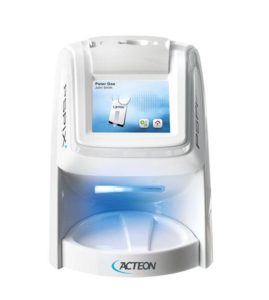
The Acteon PSPIX image plate scanner is a personal plate scanner but can be used by several people; this doesn’t, however, affect its effectiveness or the quality of images produced. It, therefore, saves time for both the staff and the doctors; what’s more, is that the production of images is super fast, and the patients can get their final reports in less time.
Using the Acetone PSPIX is pretty intuitive, as you will have to click and scan. After putting in the dental phosphor plate, you will then make a selection in the primarily provided computer interface, and the Acteon PSPIX will finish the rest of the process. The PSPIX has a small compact design that will occupy a small space in your office.
The plate scanner is also multifunctional as it will let you scan and view all the images from the different Acteon imaging devices such as the intraoral camera, panoramic, CBCT, and intraoral camera.
And to know its status since it is a multi-user, look at the color codes, purple light is an indication that the machine is in the process of scanning, a yellow light indicates that it is producing images, and blue shows that it is free for use.
Pros
- Features a color touch screen with intuitive indications
- The PSPIX is compact and portable
- The Acteon’s intellectual ability enables a smooth workflow
- Scan results are provided via the PSPIX plate scanner.
- It takes fewer minutes to give conclusive results
Cons
- Is highly power-dependent
2. Carestream CS 7200 Imaging Plate ($3,100.00)
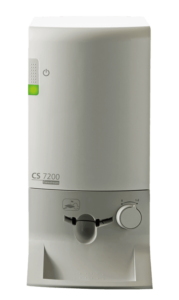
The Carestream CS is an instant phosphor plate scanner that will have your results ready in 8 seconds; the resolution quality is top-notch at 17lp/mm. Users are provided with thin reusable dental plates that feature a responsive surface, and the plates come in three different sizes, thus able to cover a wide exposure range, thus obliterating the chances of underexposure.
Pros
- Can be used in both general and pediatric dentistry
- The machine is digital, and the cable connection is via a USB
- The plate scanner has incorporated a powerful imaging software
- Comes with scratch-resistant plates that can be re-used
Cons
- Must be connected to a monitor
3. CS 7600 Carestream Plate System ($3,799.00)
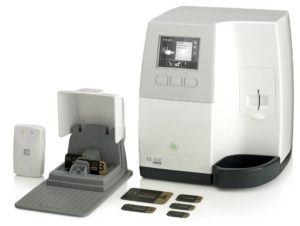
The CS 7600 Carestream plate system is a fully independent phosphor plate scanner that automatically scans the phosphor plate and produces results without mix-ups. Another advantage is in the handling of the phosphor plates; the CS 7600 Carestream comes with flexible, thin, and cableless plates that are easy to position.
The plate scanner, therefore, is a multi-user as it can be utilized for various patients at the same time.
Pros
- Produces good quality images
- Features an intuitive design
- The powerful software has facilitated the review of images and settings
- Users can be provided with the scanner and a laptop complete with software
Cons
- Phosphor plate size 0 is not accommodated, and users have to find a designated size 0 dental phosphor plate.
4. Durr VistaScan Perio Plus Image Plate Scanner ($5,810.00)
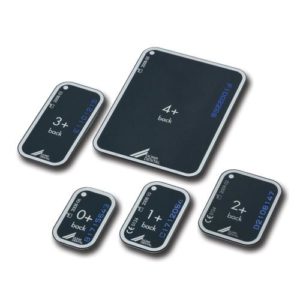
The VistaScan Perio Plus phosphor plate scanner can be used by all types of phosphor plates, including size 0. The images produced are of high quality, and an interesting fact about the VistaScan phosphor plate scanner is that it can handle up to 8 images in one go. Its size enables it to be positioned anywhere in the office and can also be moved easily.
Though it does not come with its computer screen device, it allows connection to an outside PC monitor via a USB cable. Phosphor plate insertion into the cassettes does not involve a steep learning curve, and the cassettes can hold up to two dental plates at a time. Reading and erasing the high number of phosphor plates is almost instant as it can handle up to 8 images in one go.
Pros
- Produces high-quality images
- Scanning and processing is fast
- Features a one-step scan and deletion of up to 8 images
- The interface for the PC is either via network or USB
Cons
- Highly dependent on electrical power
5. Planmeca ProScanner Imaging Plate Scanner ($6,666.00)
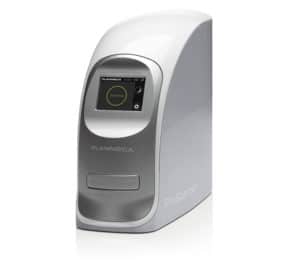
The Planmeca ProScanner has raised the bar high for other phosphor plate scanners in the market. Besides the fact that it produces bright images in very few seconds, it will first allow you to preview the images, and if you are impressed, then you can proceed to scan. It has also incorporated an embedded eraser to preparer the dental phosphor plates for the next assignment.
It might also be safe to say that technology resides in the Planmeca phosphor plate scanner because its manufacture features an SD card that can be used to store up to 100 most recent images for security purposes.
Pros
- Comes with dental phosphor plates of all sizes
- Perfect for all size clinics and can be used in multiple treatment rooms
- The dental phosphor plates can store a patients name
- The LCD enables image preview
Cons
- Is fully compatible with only Mac and Windows
6. ScanX Duo Phosphor Plate Scanner ($5,999.00)
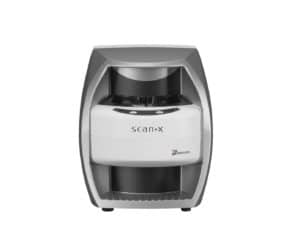
ScanX, like other machines, will give you results fast, but what makes it stand out from the rest is that the provided Scanx dental phosphor plate is thinner than the standard phosphor plate, thus enhancing a patient’s comfort. The read and delete have been automatically programmed, after which the scan will automatically be ready for the next scan.
Pros
- Has incorporated two processing slots that can run simultaneously
- The wafer-thin dental phosphor plate offers comfort to patients
- Image development is fast
- Using the plate scanner is pretty intuitive
Cons
- Does not incorporate its computer screen
7. Digora Optime Imaging Plate Scanner ($5,555.00)
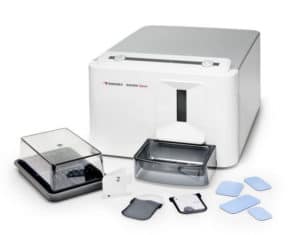
Universadent
The Digora phosphor plates feature a high resistance to wear, and if taken care of properly, then they will give you a long service. What’s more, is that they are comfortable to use in the patient’s mouth and are flexible.
Using phosphor plate scanners can be tricky at times because the gray level of the image might hinder you from making a final report. This, we can, therefore, say, is a diagnostic quality problem. However, for the Digora, it automatically adjusts the grey areas, which in the long run, enhances the diagnostic quality.
Pros
- Image processing is fast
- The plate scanner is fully automated
- Repeat use of the phosphor plates does not affect image quality
- Features an intuitive design
Cons
- Has to be connected to an external monitor
8. VistaScan Nano Easy Image Plate Scanner ($3,999.00)
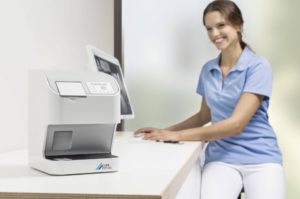
The VistaScan Nano Easy has done very well on some of the basic features. For example, it does not produce irritating sounds upon use, and its compact size makes it possible to be situated anywhere within the room. And besides providing high-quality images, it is a low maintenance machine.
The phosphor plate scanner features an intuitive design that enables the importing and deletion of images embedded on the dental phosphor plates. The action of importing and deleting plus the preparation of the phosphor plates for the next assignment is a single button process.
Pros
- Can be easily integrated with third-party software
- The phosphor plate scanner features an intuitive operational design
- The images produced do offer a perfect representation
- Features a compact and mobile structure
Cons
- Can only accommodate plates of sizes (S0, S1, and S2)
9. VistaScan Mini View Image Plate Scanner ($6,500.00)
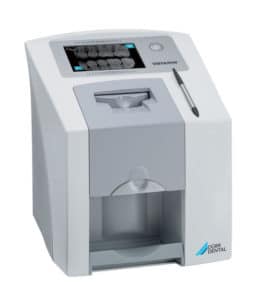
Not only is the VistaScan Mini view compact but has incorporated a high-resolution user interface for ease of use. Images produced are of high quality, and the scan manager ensures optimum workflow; the phosphor plate scanner is equipped with an internal memory that makes it very reliable.
Important to note is that the phosphor plate scanner enables WI-FI functionality, and produces very reliable patient diagnostics.
Pros
- The plate scanner is quipped with intuitive controls
- The scanner is compact thus mobile
- Its image quality is top-notch as it can depict D1 caries lesions
- Features an internal memory for the storage of images
Cons
- The PC connection is via WLAN or LAN
10. VistaScan Mini Plus Image Plate Scanner ($5,999.00)
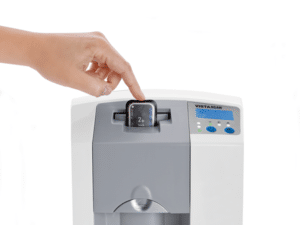
The VistaScan Mini Plus is a digital x-ray dental phosphor plate scanner that can comfortably handle phosphor plates of sizes 0-4; the active surface area of the VistaScan phosphor is also very responsive. Image production takes as little as 6 seconds with easy read and erases functionalities; what makes the plate scanner stand out is the provided energy-saving standby function.
Pros
- Integration is accessible to third-party software packages via the twain drivers or plugins
- Produces high-quality images
- The phosphor scanner is flexible, as it can be used with phosphor plates of 0-4 sizes
- Features a compact structure thus portable
Cons
- Does not include a computer screen interface
Conclusion
It would be unfair to generalize and say that all the above scanners work the same, but we can say that they are intuitive, compact, and produce high-quality images.
Some of the Dental Phosphor come with their dental phosphor plates while others don’t, connection to an external monitor also differs because some use the WLAN/LAN while others use a USB cable and some come with their screen.
Dr. John C Chao is an Orthopedic Surgery Specialist in Atlanta, Georgia. He graduated with honors from University Of Texas Southwestern Medical School At Dallas in 2007. Having more than 12 years of diverse experiences, especially in ORTHOPEDIC SURGERY,


